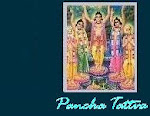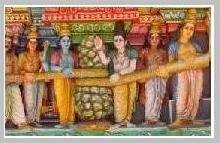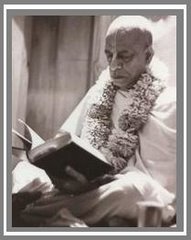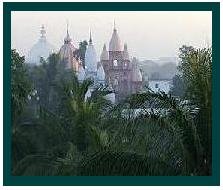Every Saint has a Past
&
Every Sinner has a Future
"Athato Brahma-Jijnasa.. Now in this human form of life, inquire about the absolute truth". - Vedanta Sutra -
 In the book of Sri Vrindavana Das Thakur ( Chaitanya Bhagavat), one discovers many detailed descriptions of Nityananda Prabhu and Chaitanya Mahaprabhu that do not seem to be elaborately depicted elsewhere.
In the book of Sri Vrindavana Das Thakur ( Chaitanya Bhagavat), one discovers many detailed descriptions of Nityananda Prabhu and Chaitanya Mahaprabhu that do not seem to be elaborately depicted elsewhere. The concept of divinity even in vegetation, trees etc has been prevalent in Vedic civilization since time immemorial and have been accepted as a tradition.
The concept of divinity even in vegetation, trees etc has been prevalent in Vedic civilization since time immemorial and have been accepted as a tradition.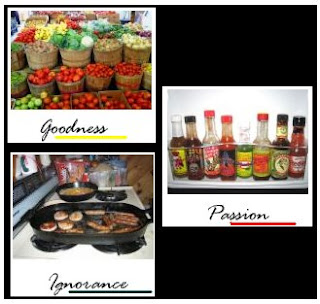 "Foods in the mode of goodness increase the duration of life, purify one's existence and give strength, health, happiness and satisfaction. Such nourishing foods are sweet, juicy, fattening and palatable. Foods that are too bitter, too sour, salty, pungent, dry and hot, are liked by people in the modes of passion. Such foods cause pain, distress, and disease. Food cooked more than three hours before being eaten, which is tasteless, stale, putrid, decomposed and unclean, is food liked by people in the mode of ignorance".
"Foods in the mode of goodness increase the duration of life, purify one's existence and give strength, health, happiness and satisfaction. Such nourishing foods are sweet, juicy, fattening and palatable. Foods that are too bitter, too sour, salty, pungent, dry and hot, are liked by people in the modes of passion. Such foods cause pain, distress, and disease. Food cooked more than three hours before being eaten, which is tasteless, stale, putrid, decomposed and unclean, is food liked by people in the mode of ignorance".  When Gokulananda (Krsna) went to the meadows, Queen Yasoda became eager to prepare His meal, so she engaged everyone in the house. Although all the people in her house were busily engaged in their duties and were all excited with love for Krsna, still Yasoda, bathed by the nectar of affection for her son, directed them all. She told her maidservants: “0 Girls! My boy will now return from the barn with Balarama, skinny and hungry, so quickly start cooking! Bring spinach, radish, golden flowers, mung dal, fruits, leaves, ginger, ground nuts, sour spices, turmeric, pepper, camphor, sugar, cumin seeds, cream, tamarind, hing, honey, Jati fruits, cassia leaves, liquorice, cane sugar, ingredients for puddings, sea salt, coconut pulp, whole wheat, ghee, yoghurt, Tulasi-rice and whole rice, and bring milk from a cow that was sent here this morning by Nanda Maharaja. Bring all these items to the kitchen for preparation!”
When Gokulananda (Krsna) went to the meadows, Queen Yasoda became eager to prepare His meal, so she engaged everyone in the house. Although all the people in her house were busily engaged in their duties and were all excited with love for Krsna, still Yasoda, bathed by the nectar of affection for her son, directed them all. She told her maidservants: “0 Girls! My boy will now return from the barn with Balarama, skinny and hungry, so quickly start cooking! Bring spinach, radish, golden flowers, mung dal, fruits, leaves, ginger, ground nuts, sour spices, turmeric, pepper, camphor, sugar, cumin seeds, cream, tamarind, hing, honey, Jati fruits, cassia leaves, liquorice, cane sugar, ingredients for puddings, sea salt, coconut pulp, whole wheat, ghee, yoghurt, Tulasi-rice and whole rice, and bring milk from a cow that was sent here this morning by Nanda Maharaja. Bring all these items to the kitchen for preparation!” While at Krishnagar, one night, Bhakti Vinode was thinking deeply on the site of birthplace of Chaitanya Mahaprabhu on the roof of his residence in Navadvipa he is said to have seen in a vision a luminous building towards the north east. He was filled with wonder. The next moming he asked for the particulars of the place from which the vision had appeared to him. He was told that the ruins of the Ballal's palace are to be found there. He went to the place with such topographical accounts old maps and other data, as he could gather for his investigations. On enquiry he leamt from the local people that it was the Birth place of Sri Chaitanya. They pointed out an extensive mound covered with Tulasi plants as the actual site of the house of Sri Chaitanya. They added that they used to point out from generation to generation. It was a blissful moment when he realised that he had at last succeeded in his attempt which had cost him so much anxiety. Thakura Bhakti Vinode then composed his famous Navadvipa Dhama Mahatmya in praise of every place within the circle of Navadvipa. - BVTM
While at Krishnagar, one night, Bhakti Vinode was thinking deeply on the site of birthplace of Chaitanya Mahaprabhu on the roof of his residence in Navadvipa he is said to have seen in a vision a luminous building towards the north east. He was filled with wonder. The next moming he asked for the particulars of the place from which the vision had appeared to him. He was told that the ruins of the Ballal's palace are to be found there. He went to the place with such topographical accounts old maps and other data, as he could gather for his investigations. On enquiry he leamt from the local people that it was the Birth place of Sri Chaitanya. They pointed out an extensive mound covered with Tulasi plants as the actual site of the house of Sri Chaitanya. They added that they used to point out from generation to generation. It was a blissful moment when he realised that he had at last succeeded in his attempt which had cost him so much anxiety. Thakura Bhakti Vinode then composed his famous Navadvipa Dhama Mahatmya in praise of every place within the circle of Navadvipa. - BVTM Feb 21 2008 - Vrindavan
Feb 21 2008 - Vrindavan
 Sri Chaitanya Mahaprabhu was born in Mayapur in the town of Nadia, just after sunset on the evening of the 23rd Falgun, 1407 Advent of Sakabda (Feb/18/1486) . The moon was eclipsed at the time of His birth and people of Nadia were all engaged, as usual on such occasions, in bathing in the Bhagirathi with loud cheers of Hari Hari bol.
Sri Chaitanya Mahaprabhu was born in Mayapur in the town of Nadia, just after sunset on the evening of the 23rd Falgun, 1407 Advent of Sakabda (Feb/18/1486) . The moon was eclipsed at the time of His birth and people of Nadia were all engaged, as usual on such occasions, in bathing in the Bhagirathi with loud cheers of Hari Hari bol. "Radharani is fifteen days younger than Krishna. When Krishna was a boy, He played with the children of the countryside, and because He was so beautiful, all the girls prayed that someday He would be their husband. Since Radha loved Krishna the most, She is the symbol of greatest worship. Krishna and the gopis, the cowherd girls, were the same age, but because girls are married earlier than boys, they were all married before Krishna. Yet, despite their marriages, they all loved Krishna so much that whenever He would play His flute, they would leave their homes and go to Him. This continued until Krishna was sixteen; then He left His friends and went to live with His real father in Mathura, and all His friends spent the rest of their lives weeping and longing for Him. Radha and Krishna met again during a solar eclipse at Kurukshetra, and it was a meeting of love, but then They were again separated. Radha is Krishna’s beloved, and by Her blessings Krishna will accept us. ‘Hare’ means Radha, so when we chant Hare Krishna, we are chanting Radha Krishna. We say Radha’s name first because Krishna loves Her.” ACBSP
"Radharani is fifteen days younger than Krishna. When Krishna was a boy, He played with the children of the countryside, and because He was so beautiful, all the girls prayed that someday He would be their husband. Since Radha loved Krishna the most, She is the symbol of greatest worship. Krishna and the gopis, the cowherd girls, were the same age, but because girls are married earlier than boys, they were all married before Krishna. Yet, despite their marriages, they all loved Krishna so much that whenever He would play His flute, they would leave their homes and go to Him. This continued until Krishna was sixteen; then He left His friends and went to live with His real father in Mathura, and all His friends spent the rest of their lives weeping and longing for Him. Radha and Krishna met again during a solar eclipse at Kurukshetra, and it was a meeting of love, but then They were again separated. Radha is Krishna’s beloved, and by Her blessings Krishna will accept us. ‘Hare’ means Radha, so when we chant Hare Krishna, we are chanting Radha Krishna. We say Radha’s name first because Krishna loves Her.” ACBSP
 Among Newton's acquaintances and fellow scientists was an atheist, with whom he would sometimes debate. One morning this man paid Sir Isaac Newton a visit. When he entered Newton's study, he noted a remarkably well-made replica of the universe sitting on his desk. The model was complete with rotating planets, and Newton's associate was quite impressed by its detail and authentic nature.
Among Newton's acquaintances and fellow scientists was an atheist, with whom he would sometimes debate. One morning this man paid Sir Isaac Newton a visit. When he entered Newton's study, he noted a remarkably well-made replica of the universe sitting on his desk. The model was complete with rotating planets, and Newton's associate was quite impressed by its detail and authentic nature. This is the Hindu deity Shiva ( Shiva Lingum ). This piece is at present on view in the Etruscan Museum at the Vatican in Rome. Encyclopedia Britannica mentions under the headings "Etruria" and "Etruscan" that between the 2nd and 7th centuries BC, northern Italy was known as Etruria.
This is the Hindu deity Shiva ( Shiva Lingum ). This piece is at present on view in the Etruscan Museum at the Vatican in Rome. Encyclopedia Britannica mentions under the headings "Etruria" and "Etruscan" that between the 2nd and 7th centuries BC, northern Italy was known as Etruria.  We all are servants of servants of servants of Srilla Bhaktivinoda Thakura and all our knowledge and understanding is uprising from his teachings and books. We are members of the glorious transcendental family of Srilla Bhaktivinoda Thakura, Bhaktivinoda parivara and therefore, we take his words as supreme guidance and shelter.
We all are servants of servants of servants of Srilla Bhaktivinoda Thakura and all our knowledge and understanding is uprising from his teachings and books. We are members of the glorious transcendental family of Srilla Bhaktivinoda Thakura, Bhaktivinoda parivara and therefore, we take his words as supreme guidance and shelter. The main thing is that whenever prasadam is offered to the Lord, everything should be very respectfully and cleanly presented and prepared.
The main thing is that whenever prasadam is offered to the Lord, everything should be very respectfully and cleanly presented and prepared. The Parrot of Sri - In the Srimad' Bhagavatam it is often stated, sri sukadeva uvaca. Sri means sriya sukadeva, or the suka, parrot of Sri - Srimati Radharani.
The Parrot of Sri - In the Srimad' Bhagavatam it is often stated, sri sukadeva uvaca. Sri means sriya sukadeva, or the suka, parrot of Sri - Srimati Radharani.  Our Guru Maharaja ( Kesava Maharaj ) realized the glories of Guru. After taking diksa from Srila Prabhupada Bhaktisiddhanta Sarasvati Thakura, he never could say “Prabhupada”; when he did, he began to weep loudly. He wanted to glorify him, but his mood became so high that he couldn’t. He used to say, “Krsna came to this world, but He didn’t save me. Sri Caitanya Mahaprabhu and Nityananda Prabhu also came here, and They saw me here. Narada and others were here, but they also did not save me. My Gurudeva, Srila Bhaktisiddhanta Sarasvati Thakura, took my sikha and dragged me from the well of hell. He took me under his shelter and gave me Krsna.”
Our Guru Maharaja ( Kesava Maharaj ) realized the glories of Guru. After taking diksa from Srila Prabhupada Bhaktisiddhanta Sarasvati Thakura, he never could say “Prabhupada”; when he did, he began to weep loudly. He wanted to glorify him, but his mood became so high that he couldn’t. He used to say, “Krsna came to this world, but He didn’t save me. Sri Caitanya Mahaprabhu and Nityananda Prabhu also came here, and They saw me here. Narada and others were here, but they also did not save me. My Gurudeva, Srila Bhaktisiddhanta Sarasvati Thakura, took my sikha and dragged me from the well of hell. He took me under his shelter and gave me Krsna.”

